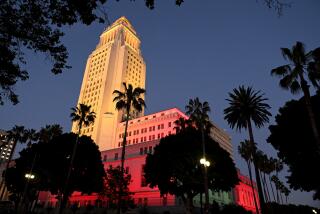How Neighborhood Councils Can Enliven Urban Democracy
- Share via
Advocates of neighborhood councils, which are part of the new charter whose fate will be decided June 8, describe them as potential saviors of modern urban democracy. Opponents say they will exclude people and create more bureaucracy in the service of the status quo. The truth is, the people sitting on the councils will determine how they will affect governance. Meantime, it might be helpful to examine what is, for all practical purposes, an existing neighborhood council and then imagine how a divided community could benefit from forming one.
The new charter would create two structures: a Department of Neighborhood Empowerment, which would allocate resources to the councils, train their staffs and serve as the link between them and City Hall; and a seven-member board, reflecting geographic diversity, that would oversee policy and certify neighborhood councils once the rules governing their formation were formulated by the City Council. To win certification, a neighborhood council would have to show it is open to everyone who lives, works or owns property in a community, suitably reflects the area’s diversity of interests and employs a fair method by which to choose its officers.
There is a very good example of an existing neighborhood council in Los Angeles: the 8th District Empowerment Congress. Since it was established six years ago by Councilman Mark Ridley-Thomas, the congress has helped attract some $300 million to the district; create more than 1,000 jobs; transform more than 100 liquor stores into other businesses; and educate local residents about how the city works, thereby making them more effective participants. Its leaders, who often belong to community-based redevelopment groups and other grass-roots efforts, believe their organization has improved the quality of city services in the district and that their activities empower them. Congress leadership meets monthly, and four areas of the 8th District hold quarterly community meetings. Once a year, it holds a general meeting and workshops.
The success of the Empowerment Congress is certainly attributable to Ridley-Thomas’ commitment to it. But the Constituency Service Center, which facilitates citizen contact with the city, is no less important. The center provides residents with one-stop city-service shopping, which greatly increases the chances of, say, getting a tree-trimmer to come to your neighborhood.
Overall, the Empowerment Congress enables its members to address problems, define goals and mobilize support for projects. Most members are African Americans with deep roots in the city and their neighborhoods. Yet, the 8th District is changing demographically, and only some of its needs can be met by obtaining more funding to rebuild sewers, sidewalks and stores. Still, because the congress is a community-based structure, the problems it faces as a result of changing circumstances are more likely to be managed successfully if the affected groups are directly involved, particularly if there is machinery that can engage all sides and if there are local leaders trained in mediation.
Across downtown, on the other side of its government buildings and the Music Center, the Filipino community has long wanted to create its own version of Chinatown or Little Tokyo. Filipinos, the largest Asian community in California, have been living in the area for more than half a century. The biggest constraint on the development of a “Manilatown” has been continuing divisions within the community that reflect fissures back home in the Philippines. A neighborhood council could be Filipinos’ best vehicle to protect what they have left from encroaching Koreatown by providing a forum for mediating long-standing differences.
True, a neighborhood council would have to include non-Filipinos, but it would enable Filipinos, through training in mediation and its practice, to overcome much of the frustration that divisions have spawned. Interestingly, in the Philippines, there are councils, called “barangay,” at the barrio or town level.
While no governance model can be transferred entirely from one community to another, the reality in Los Angeles is that most of its immigrants came from communal-oriented societies: villages in Mexico, family associations in China, the barangay in the Philippines. Immigrants of the last major migration also came from largely communal societies, in Europe and Eastern Europe. But what welcomed them was also communal in nature: the local party machine, which looked after their needs for a job and a place to live. It also served as a bridge to U.S. political culture and sustained their belief in it for generations. Neighborhood councils could play a similar role for today’s immigrants.
Another reason neighborhood councils are desirable is not just what they could do for their local communities, but that the charter provides the means for communication between a council and its community and among all the city’s councils and their communities. At least one annual meeting of all neighborhood councils--a citywide convention, if you will--is called for in the charter. Like the 8th District’s annual get-together, such a convention would give councils the opportunity to evaluate their past work, participate in workshops to develop their knowledge and skills and meet their counterparts from across the city. It is only by participating in the larger picture that Angelenos will overcome the sense that they are not getting their “fair share.” Community is not just a narrow geographical notion. It can also mean shared interests and broader visions.*


